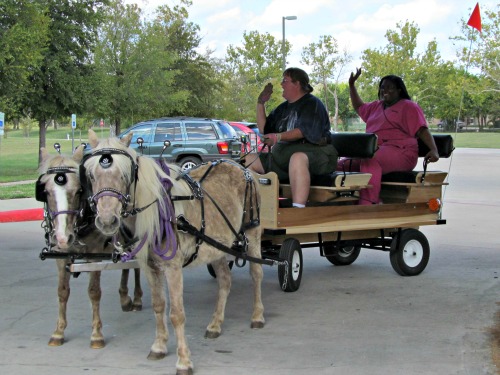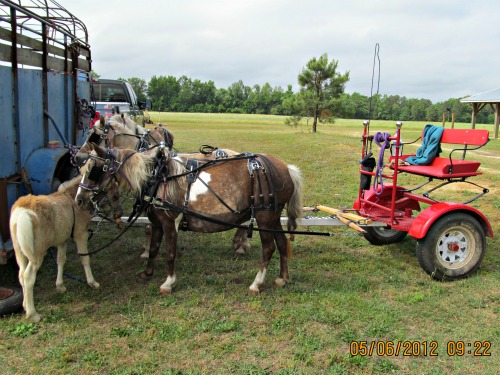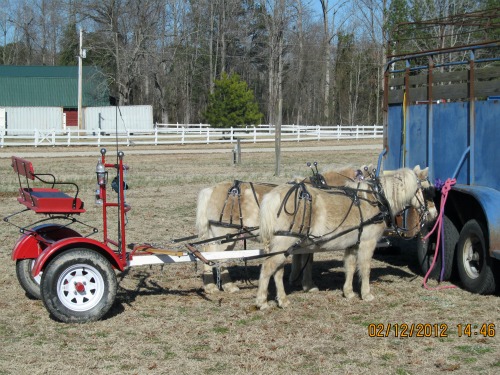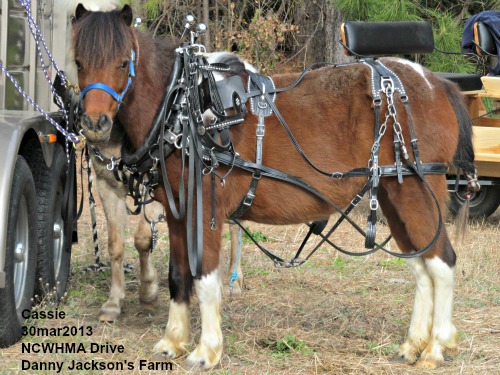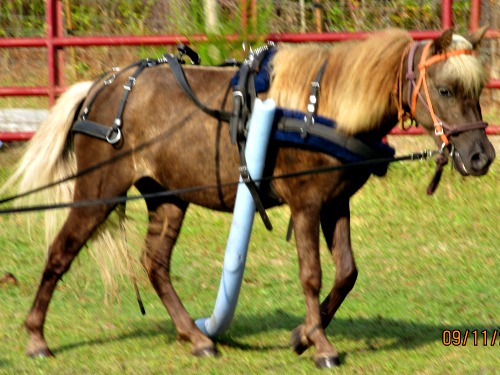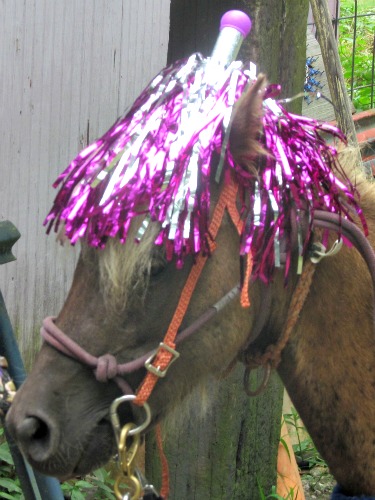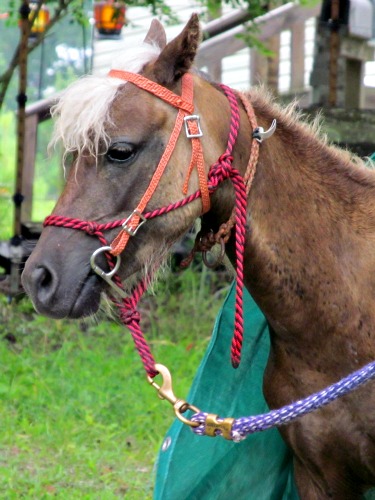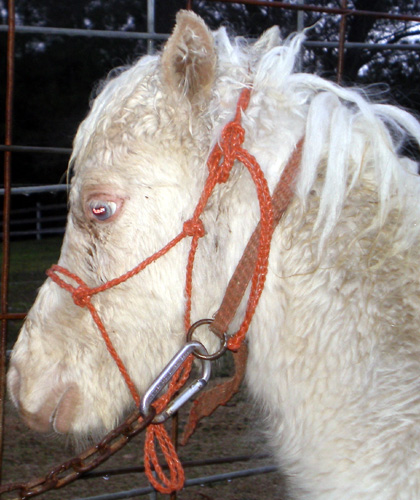Just to be clear - at home most of you harness your ponies while tied in a halter; then you tie the halter around their necks and bridle them; then you hitch them. I'm not sure if you tie them with the reins after being bridled, but must assume that you don't tie with the reins and they are expected to stand still until you're ready to take off. How is that safer than putting on the bridle last, all the while the pony is tied with the halter either on or around his neck? No, I don't tie them with the lines or w/ a lead rope directly to the bit. I have used a lead rope around the neck and run thru one side of the bit to tie them if don't have a halter. If I'm hitching while they are tied, the halter is either left on under the bridle or is put back on after he is bridled and tied to be hitched. The lines are run thru the rings and left hanging on the harness - both in working harness or in pleasure/show harness. IF hitching in the open (and I do this alone a lot), then the halter/lead may be removed (now I drive w/ it on most of the time). The pony is ground driven to the vehicle and depending on the vehicle and pony is either backed between the shafts and then expected to stand while hitched or is "parked" and the cart shafts lifted straight up and cart moved into position to be hitched and the shafts dropped down to put into shaft carriers. I don't turn the lines loose, I hold them and switch sides. I don't dawdle while hitching and if pony isn't holding still or isn't responding to "whoa, stand" - they need more work. Either in the commands/response or to take the 'fresh off".
It's safer to have them tied w/ halter either under or over the bridle when you go to hitch them. The standard is to never have a bridleless horse hitched.
Do you all agree that it's OK to put a halter on top of the bridle to tie up your harnessed and hitched pony, or is that frowned upon, too? I don't mean to leave the pony hitched and tied while I leave, but just until I can get my act together, lock the tack room door, etc. I work alone. YES
I've been driving for 6 years now and have never had a problem with either bridling a hitched pony or with putting a halter on top of a bridled and hitched pony and tying him for a few minutes under my supervision. Have I just been lucky so far? I've never considered it safe to have both a halter and bridle removed from a horses head while he is hitched.
The Amish tie their hitched horses every day. People have been doing it for hundreds of years. You are right. They have. They also are not all perfect, they do/have had accidents (especially recently - some including deaths and have happened when a bridle came off of a horse while hitched) AND their horses are worked hard and often every day of the week.
When I'm working ponies in work harness, they wear their halters under their bridles at home and at most events we attend. In fact, at most, I will keep at least one lead rope on one pony and it is attached to the hames - that way they can be tied out on the trail or in the field as well. That has also "saved us" when we had a major driving accident (green pony acted up crossing a water crossing and forced pair out into the boggy spot and sank/were stuck. Used lead ropes to help w/ pulling them out of the bog - one leg at a time after crawling on top of them to unhitch them from the forecart. Then lead ropes used to tie them to trees while the cart dug out and they were re-hitched after checking them to make sure they were ok. We were all a muddy mess before we got done that day!). I, too, work mostly alone and yes, they do stand tied to be hitched sometimes and others they are expected to stand while being hitched out in the open.
In this pic, you can clearly see the halter under the headstall and lead rope hanging from the hames.
This one shows the halters under the headstalls - extra lead ropes are in the wagon and the lead ropes they were tied w/ are still at the trailer. Due to all the activity this day, they were hitched while tied to the trailer - I moved the wagon up to them and pushed the tongue between them. Not the easiest to do, tell the truth! I've since had halters made for Christmas Parades that have matching lead ropes that are only 6' long (not the 10-14' I use for every day work/handling) that are then attached to the hames and w/i reach if there is ever a problem out driving. However, 6' leads are not long enough to tie to most trees if we are doing a trail drive that stops out on the trail for a break!
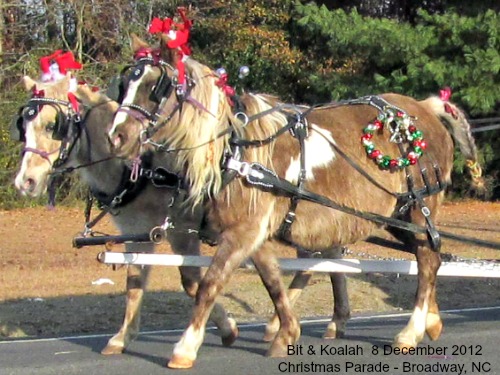
Here is probably the only pic I have of me hitching in the open... YES, the pair is EXPECTED to stand while being hitched (they were worked for an hour before getting to this point - this is their first pair hitch - both are experienced single drivers. The bl/white is experienced at being hitched single in the open, the lite silver is used to driving as a pair and is hitched both tied and out in the open). The woman taking the pics can drop camera and help if needed... The lines are held while attaching the neck yoke & traces, the brakes were set on the wagon. When I move from one side to the other, the lines move w/ me. "Whoa, stand" is used - a lot, and is meant to be obeyed. halters are on the ponies under the work headstalls and their lead ropes were left tied to the trailer - where they were first standing to run the lines for them as a pair.
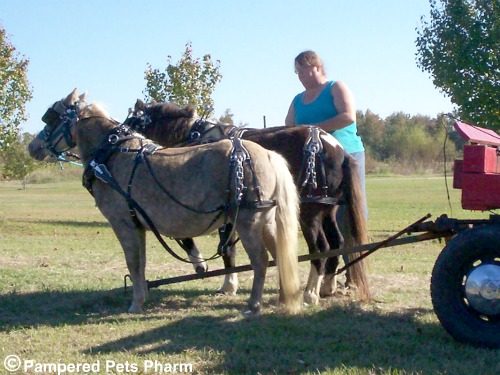
While doing a lot of driving at events - there are usually people around and a friend and I often parked next to each other to be able to help each other. We have tied our singles and pairs to the trailer - while hitching and unhitching. I usually unhitch when taking a break - don't leave them hitched and tied for extended periods of time. They are bridled before they are hitched - weather removing the halter or not. IF halter is to be completely removed before driving, then it's put on OVER the headstall while they are tied (I don't have the buckle nose halters that can be unbuckled from under the headstall) and hitched, then lines are picked up and adjusted in my hands, the halter is removed and I step back and into the vehicle. The pony is to remain standing still until i am settled and I give the command to move on. If I'm doing a pair, the pony on the right is the one untied first. I go around the back of the driving vehicle to the left side pony, gather/adjust lines, untie and then mount vehicle. The rest is the same.
I reverse it while unhitching. If the pair is to be tied, they are driven up to the trailer to where they'd been tied previously. I dismount the vehicle and gather my lines to go up to the left side of the left side horse. The halter is put on over the bridle and the left side pony is tied to the trailer. The lines are the then draped thru the harness and I go around the vehicle (brake has also been set before getting out) and halter/tie the pony on the right. Then the traces are undone, the neckyoke is undone and the wagon brake is released and the wagon is pulled backwards away from the pair. IF the pair is attached via neck/breeching ties, they are undone first - allowing the ponies to move apart a bit. The lines are undone from the bits, the halter goes around the neck, the bridle is removed, halter put back on & bridle either hung on the trailer or on the hames. I undo the pony that I feel needs to be undone first. The right side pony has all harness removed from the right, the left side pony has all harness removed from the left.
IN this pic, I'm getting ready to mount the vehicle. The left side pony is already untied. I took the pic and untangled her foal that is attached to the left side of her hames (her right foreleg is over the lead rope). Then quickly moved around my cart to the right side pony - untied her (put lead around the hames) and mounted the cart from the right.
By myself, it takes some work to get the forecart pushed up between the pair w/o hitting them in the belly or legs w/ the neck yoke or tongue when they are tied. But it is do-able and I've done it. These two pics were taken when I was totally by myself. I needed to do a drive and "get away" and no one could go w/ me. I went and made it work. I drove the pair for an hour and 30 minutes according to my notes.
I have unhitched the fore cart, and the pair have had their bridles removed (u can c them hanging on the handle of the emergency door). Sorry, it's difficult to see the lines - they are figure 8'd and hung on the hames w/ the snaps attached to the hame rings they run thru during driving. They actually wore the harness home (15 minutes away) and they were hosed off (not thoroughly) w/ harness still on as it was unseasonably warm for February that year. Then they stood sheeted while they dried enuff to turn out. They carried the harness into the barn for me for me to hang it up.
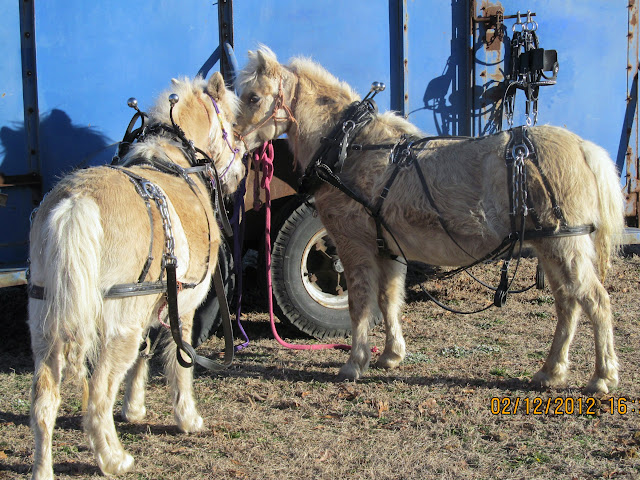
ADA and CDE events you are not allowed to tie the horse up while it is being hitched/unhitched. You are supposed to have a groom for a single and for each pair being hitched. If I remember right, at AMHR and ASPC driving events - they aren't supposed to be hitched in the barn area but only in the practice or warmup areas... Most folks also used at least one header at that time. Some used one on each side when I was watching!







































